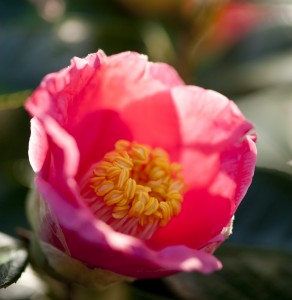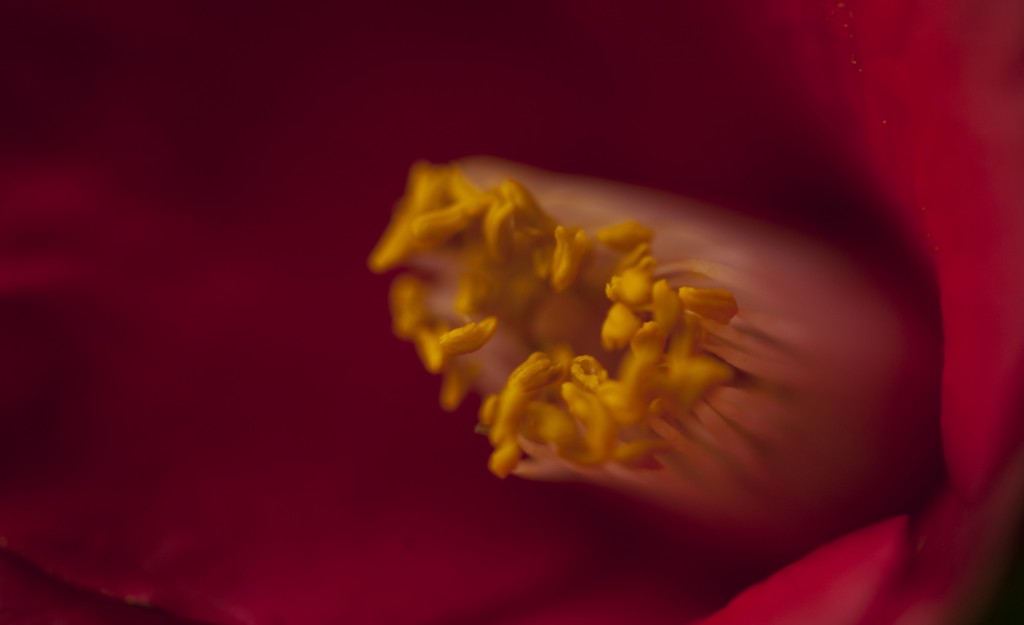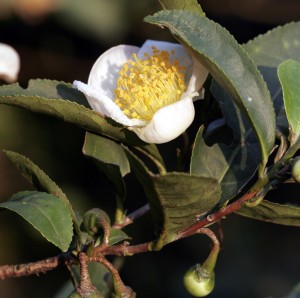Camellias: Of Form and Function
Posted in Around the Garden on February 29 2012, by Matt Newman
 The soft face of the camellia flower springs up so often on Plant Talk that I’m absolutely flabbergasted we haven’t taken a closer look at the genus before. In the fall, a few cultivars soldiered on past fluke blizzards and nippy temperatures to keep their flowers until November. And true to that form, the winter camellias have proven some of the earliest bloomers along the Ladies’ Border. I’d personally put them on the All-Star team of botanical beauties if we were ever so ridiculous as to create such a thing.
The soft face of the camellia flower springs up so often on Plant Talk that I’m absolutely flabbergasted we haven’t taken a closer look at the genus before. In the fall, a few cultivars soldiered on past fluke blizzards and nippy temperatures to keep their flowers until November. And true to that form, the winter camellias have proven some of the earliest bloomers along the Ladies’ Border. I’d personally put them on the All-Star team of botanical beauties if we were ever so ridiculous as to create such a thing.
The colors and outline of this evergreen’s flowers play on the same aesthetic fascination that many find in cherry blossoms, or the Chinese plum–the camellia is a staple of Asian artwork. And rightfully so. The range of the genus extends from the Himalayas east through Japan, and south to Indonesia. From these regions it has inevitably spread, earning fame and adoration among horticulturists, with as many as 200 species establishing themselves for their ornamental value from one side of the world to the other. But as pageant-winners go, the camellia is especially talented.
That of course depends on the variety: hardy or non-hardy. The latter only survives here in the north when kept in a glasshouse, with constant moisture and regulated warmth. Outside, we have plenty of success with the hardier hybrids bred with cold resistance in mind. With its slightly warmer climate and protection from high winds, the Ladies’ Border offers a chance for these blooms to thrive even in the middle of February. This mild winter has further given our camellias the best opportunity to flourish, though the blooming schedule this year has flirted on the edge of bizarre.
At The New York Botanical Garden, we reserve a little space at the top of our list for Camellia japonica, or the “rose of winter.” This beauty’s January-to-March inflorescence makes it perfect for winter-weary eyes, bursting into color right at that moment when you’re asking yourself if your bank account can handle a last-minute flight to Costa Rica. And the history of the flower is as rich as its blushing hues. Paintings and ceramic artwork of common red camellias have been dated as far back as 11th-century China. However, it wasn’t until 1692 that the breed found its way to Western shores via German naturalist and surgeon Engelbert Kaempfer. From there it took root in gardens throughout Europe; one Camellia japonica growing today near Dresden, Germany is rumored to have been gifted to a local botanical garden in 1780.
The legacy of the camellia in New York began shortly thereafter. Of note was the Linnaean Botanic Garden of William Prince, established ten miles from New York City around the year 1770. Its sophisticated collection of exotics included 20 winter-blooming camellia varieties as listed in a garden plant catalog from 1823. The plant isn’t exactly a newcomer.
Now, more than 240 years since Mr. Prince began his collection, there are over 2,000 recognized cultivars of C. japonica alone.

Of course, C. japonica makes itself useful beyond its pretty face and long lineage. The seeds of this species are pressed to create tea oil, a sweet seasoning and cooking oil used in certain regions of Asia. But it is the plant’s near cousin that pulls the lion’s share of weight in the culinary world.

The true star of the camellia genus isn’t grown for its flowers, vibrant as they are. You see its end product on the shelf at every grocery store, and there’s a very good chance you have at least one or two boxes of the stuff in the kitchen cabinet. This single species produces one of the most historically significant, carefully curated, and well-established staples of the beverage industry. The British have an exact time of day set aside to enjoy it. The Japanese have created elaborate ceremonies for serving it.
It’s tea, naturally.
Enjoyed loose-leaf through a strainer or as the bagged powder so convenient for dipping in a steaming mug of water, Camellia sinensis remains one of the most significant economic crops on the market. (The American colonists certainly weren’t pitching it into Boston Harbor because they didn’t like the taste.) The subtle flavor of C. sinensis‘ leaves is the most well-known, though other species can be used to make similar brews. So the next time you happen upon the sunny yellow and pink flowers along the Ladies’ Border, know that it’s more than a few colorful petals you’re seeing–it’s centuries of history, of cultivation, and of use. Form and function tend to make your garden so much more engaging.

